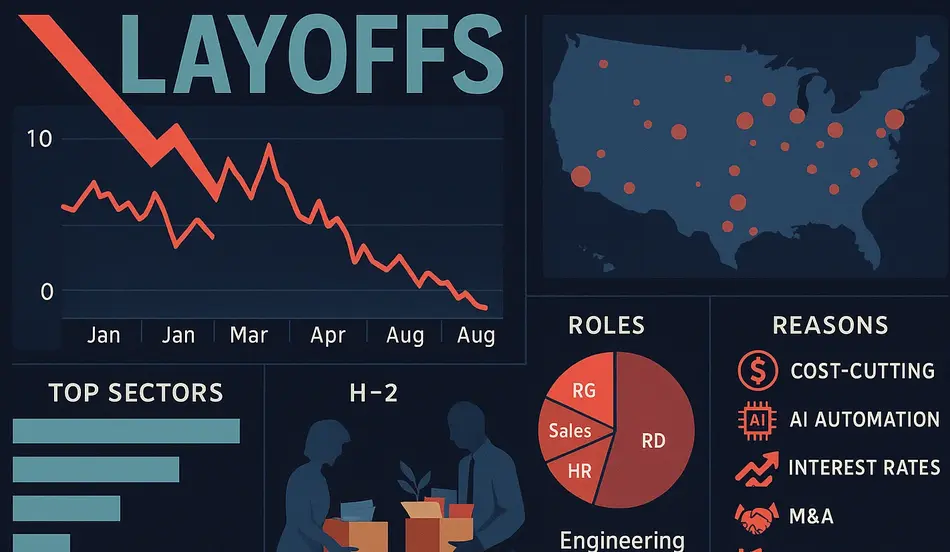Introduction
The year 2025 has marked a significant turning point in the technology sector, with tech layoffs 2025 becoming a dominant headline across global business news. This comprehensive analysis delves into the causes, trends, and impacts of these layoffs, providing detailed statistics, case studies, and expert insights. Whether you are a tech professional, employer, or industry observer, understanding the dynamics of tech layoffs 2025 is crucial for navigating the rapidly evolving job market.
Table of Contents
- Overview of Tech Layoffs 2025
- Key Causes Behind Tech Layoffs 2025
- Detailed Statistics and Data
- Case Studies: Major Companies Affected
- Impacts on the Tech Industry and Workforce
- Future Outlook and Predictions
- FAQ: Tech Layoffs 2025
- Looking to Hire Fast?
Overview of Tech Layoffs 2025
In 2025, the technology sector experienced an unprecedented wave of layoffs, with over 200,000 tech workers losing their jobs globally in the first half of the year alone. The phenomenon of tech layoffs 2025 has been driven by a combination of economic uncertainty, rapid advancements in artificial intelligence, and shifting business priorities.
Historical Context
While tech layoffs are not new, the scale and speed witnessed in 2025 surpass previous downturns, including the dot-com bust and the COVID-19 pandemic era. This year’s layoffs have affected both established giants and emerging startups, signaling a structural shift in the industry.
Key Causes Behind Tech Layoffs 2025
Several interrelated factors have contributed to the surge in tech layoffs 2025:
1. Economic Downturn and Market Volatility
Global economic instability, rising interest rates, and reduced consumer spending have forced tech companies to reassess their growth strategies. Many firms have implemented cost-cutting measures, including workforce reductions, to maintain profitability.
2. Automation and Artificial Intelligence
The rapid adoption of AI and automation technologies has rendered certain roles obsolete. Companies are increasingly relying on AI-driven solutions for tasks ranging from customer support to software development, leading to significant job displacement.
3. Overhiring During the Pandemic
During the pandemic, tech companies ramped up hiring to meet surging digital demand. As the market normalized, many found themselves overstaffed, prompting widespread layoffs to realign with current business needs.
4. Shifting Business Models
Tech firms are pivoting towards more sustainable and diversified business models. This transition often involves restructuring teams, eliminating redundant positions, and focusing on core competencies.
Looking to Hire Fast?
Connect with top tech talent quickly and efficiently. Post your job openings on our platform and reach thousands of qualified candidates.
👉 Post a Job Now →Detailed Statistics and Data
The following statistics highlight the magnitude of tech layoffs 2025:
- Global Layoffs: Over 200,000 tech jobs lost in the first half of 2025.
- US Market: The US accounted for 60% of all tech layoffs, with California and Texas being the hardest-hit states.
- Role Distribution: Software engineering (35%), product management (20%), and HR/recruiting (15%) were the most affected roles.
- Company Size: 70% of layoffs occurred in companies with over 1,000 employees.
- Gender Impact: Women made up 42% of those laid off, highlighting ongoing diversity challenges in tech.
Layoff Trends by Quarter
| Quarter | Jobs Lost | Major Companies |
|---|---|---|
| Q1 2025 | 85,000 | TechCorp, InnovateX |
| Q2 2025 | 115,000 | Cloudify, DataStream |
Case Studies: Major Companies Affected
TechCorp: Navigating a 20% Workforce Reduction
TechCorp, a leading cloud services provider, announced a 20% reduction in its global workforce in March 2025. The company cited declining enterprise demand and increased automation as primary reasons. Despite the layoffs, TechCorp invested heavily in AI research, signaling a shift in strategic priorities.
InnovateX: Restructuring for the Future
InnovateX, known for its consumer electronics, laid off 5,000 employees, primarily in R&D and support roles. The company’s CEO emphasized the need to streamline operations and focus on emerging markets such as IoT and smart devices.
Cloudify: The Impact of AI Integration
Cloudify’s adoption of advanced AI tools led to the automation of several backend processes, resulting in the layoff of 3,500 staff. However, the company also created new roles in AI ethics and data governance, illustrating the evolving nature of tech employment.
Impacts on the Tech Industry and Workforce
Short-Term Effects
- Increased competition for remaining tech jobs
- Pressure on salaries and benefits
- Greater emphasis on upskilling and reskilling
Long-Term Implications
- Acceleration of AI and automation adoption
- Shift towards contract and gig-based work
- Potential for new job categories in AI, cybersecurity, and data science
Future Outlook and Predictions
Experts predict that while tech layoffs 2025 have created short-term challenges, they may ultimately drive innovation and efficiency. Companies that invest in employee retraining and embrace new technologies are likely to emerge stronger. The job market is expected to stabilize by late 2026, with new opportunities in AI, green tech, and cybersecurity.
FAQ: Tech Layoffs 2025
What are the main reasons for tech layoffs in 2025?
Economic downturn, overhiring during the pandemic, rapid AI adoption, and shifting business models are the primary causes.
Which roles are most affected by tech layoffs 2025?
Software engineering, product management, and HR/recruiting roles have seen the highest layoffs.
How can tech professionals protect their careers?
Upskilling in AI, data science, and cybersecurity, as well as networking and flexibility, are key strategies.
Are any new opportunities emerging despite the layoffs?
Yes, roles in AI ethics, data governance, and green technology are on the rise.
Conclusion
The tech layoffs 2025 wave has reshaped the technology industry, presenting both challenges and opportunities. By understanding the underlying causes, analyzing the data, and preparing for future trends, professionals and companies can navigate this period of transformation and emerge stronger in the years ahead.




